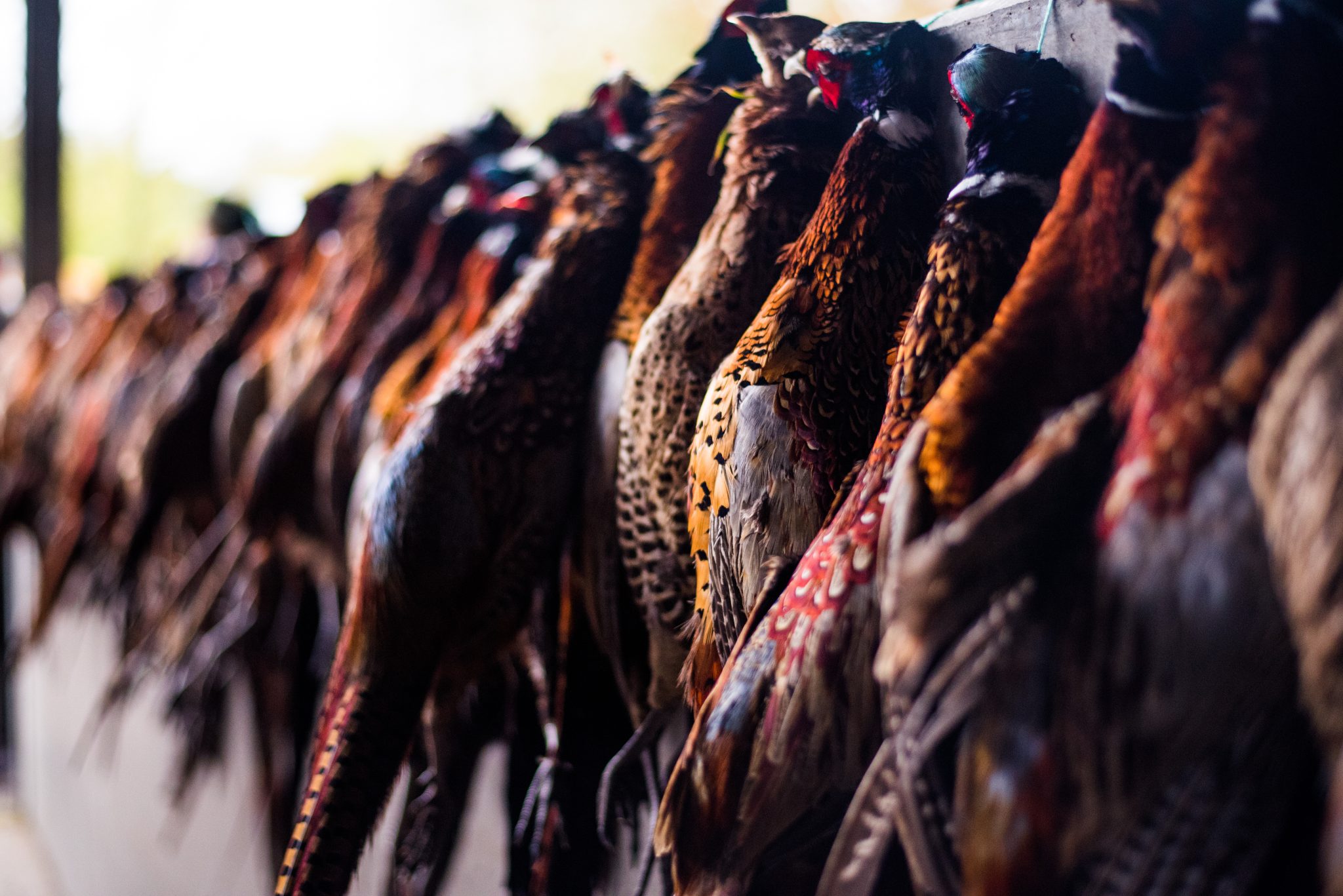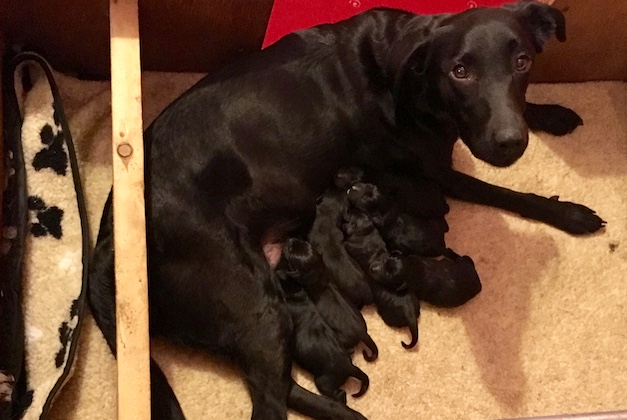Win CENS ProFlex DX5 earplugs worth £1,149 – enter here
What to expect when your gundog bitch gives birth
In the concluding part of a two-part series, Tony Price guides breeders through the process of bringing their working bitch’s puppies into the world
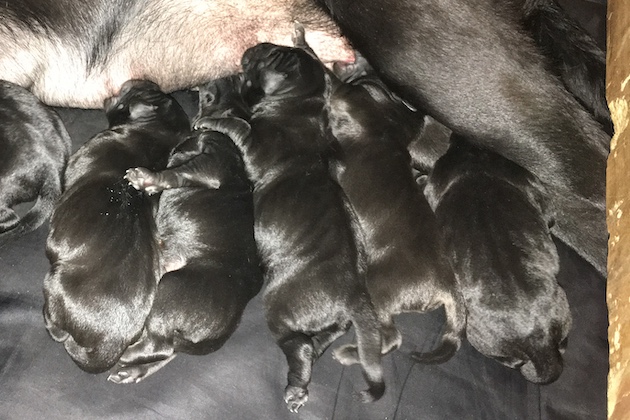 Pumba has had 7 beautiful puppies but sadly number 8 had died a few days ago and she had to have help from the vets to get it out after 5 hours of trying. Fortunately she is fine and has 4 healthy bitches and 3 healthy dogs.
The first one is the first puppy born. The puppy I am going to keep is called Briar and a little girl
Pumba has had 7 beautiful puppies but sadly number 8 had died a few days ago and she had to have help from the vets to get it out after 5 hours of trying. Fortunately she is fine and has 4 healthy bitches and 3 healthy dogs.
The first one is the first puppy born. The puppy I am going to keep is called Briar and a little girl
Preparing for birthing dogs
You need to carry out some practical tasks before the puppies arrive. This includes making a whelping box and thinking about where you are going to put it. It should be in an area free of any draughts and somewhere warm that doesn’t go below 23°C, because newborn puppies cannot control their body temperature.
At Tawnyhill we put shredded paper in the whelping box prior to whelping because we have noticed that the bitches like to begin ‘nesting’ and tearing up the paper. However as soon as the whelping begins you must swap the paper for towels.
Buy yourself a pair of sharp scissors, keep them sterile and have them to hand.
Signs to look out for
Your bitch is likely to begin birthing dogs soon when:
- She either refuses her evening meal or eats it then vomits it up shortly afterwards
- She is panting or looking stressed
- Her temperature has dropped (check it with a thermometer)
Should you help?
Your bitch may be very mothering and capable of doing all the work for birthing dogs herself, including cleaning the puppies up, biting through the cord and eating the placentas. Many people get up in the morning to find a litter of healthy puppies suckling on a very happy new mother. However, if you do have to help birthing dogs, here are a few tips you can use to assist your bitch.
When the birth is imminent, the bitch may start vigorously licking her rear end, groaning and physically pushing. Her tail will go up and you may be able to see a small bag of liquid. However, this might have already ruptured, spilling the fluid onto the bedding. This fluid can be a variety of colours, ranging from clear through to a bloody brown colour or even green.
If this is the bitch’s maiden litter the first puppy may take some time to be produced. Assist with the birth by gently but firmly easing the puppy out by pulling down, away from the bitch’s tail. This is most important if the puppy is being presented backwards, to prevent it drowning.
Once fully produced, the puppy’s airway should be immediately cleared of any mucus and skin etc. With the puppy lying in one hand, with its head lower than its body, vigorously rub its chest cavity with a towel using the other hand. This should stimulate the puppy into coughing and then breathing.
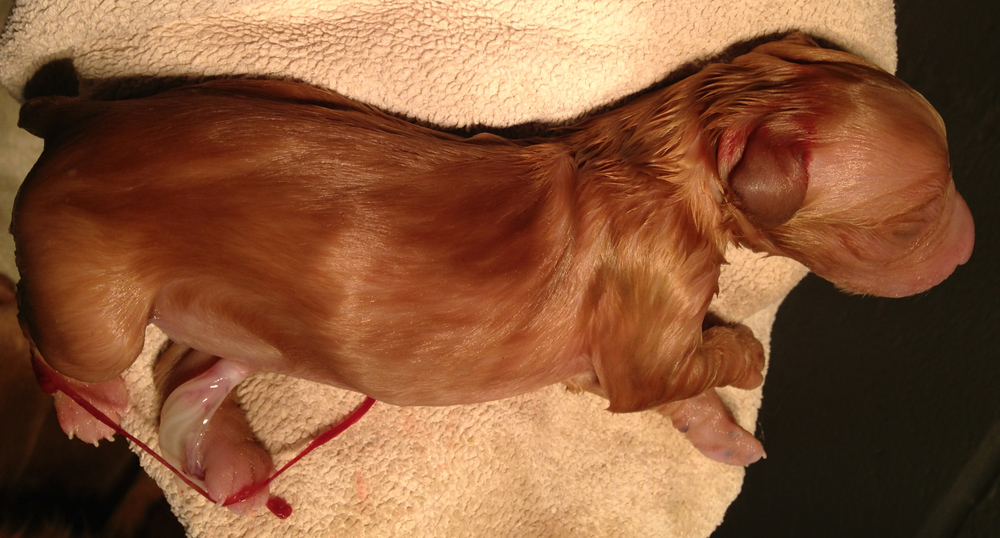
A newborn puppy
Cutting the cord
If the umbilical cord appears to be still attached inside, do not pull the puppy, but grip the cord as far away from the puppy as is practical and gradually apply pressure to ease it out. If the puppy’s navel is put under pressure, either by you or by the bitch biting through the cord, a navel hernia can easily develop.
Cut the cord no closer than two inches to the puppy’s navel. The remaining cord will dry up and drop off by the following day.

A bitch can cause a navel hernia on a puppy by biting through the umbilical cord too near the puppy or by swinging the puppy by the cord
Problems to watch out for
If, at any time during the latter part of pregnancy or the whelping, the bitch’s gums become pale, veterinary advice should be sought immediately. This should also be done if, after four hours of obvious labour, no puppies have been produced.
Since 1 January 2012, the Kennel Club will no longer register any puppies born from a bitch that has previously had two caesarean sections. However, we do not often find it necessary to have this operation performed. Using the method of injecting the bitch with oxytocin and calcium usually stimulates the birth of another puppy around 20 minutes later. If one puppy is produced, but no more make an appearance for two hours, it may be worth walking the bitch around outside.
Resuscitating newborn puppies
Some puppies may appear to be dead at birth, but it is well worth persevering to try to resuscitate them for a considerable length of time — even up to 10 minutes after the birth.
Suckling the puppies
Once breathing and separated from its placenta, a puppy should be attached to one of the bitch’s nipples. She will probably turn and lick this puppy vigorously. With some gentle persuasion, you should insist on the bitch lying down and the puppy being allowed to suckle. This will induce the release of oxytocin by the bitch, thus making her produce more puppies.
We have found that some bitches are so preoccupied with nursing their first puppy that it can be up to four hours before they produce a second one. With a maiden bitch birthing dogs they may even produce a second puppy without realising.
If any puppies appear to be smaller than the rest, they should be helped to suckle about every two to three hours for the first two days.
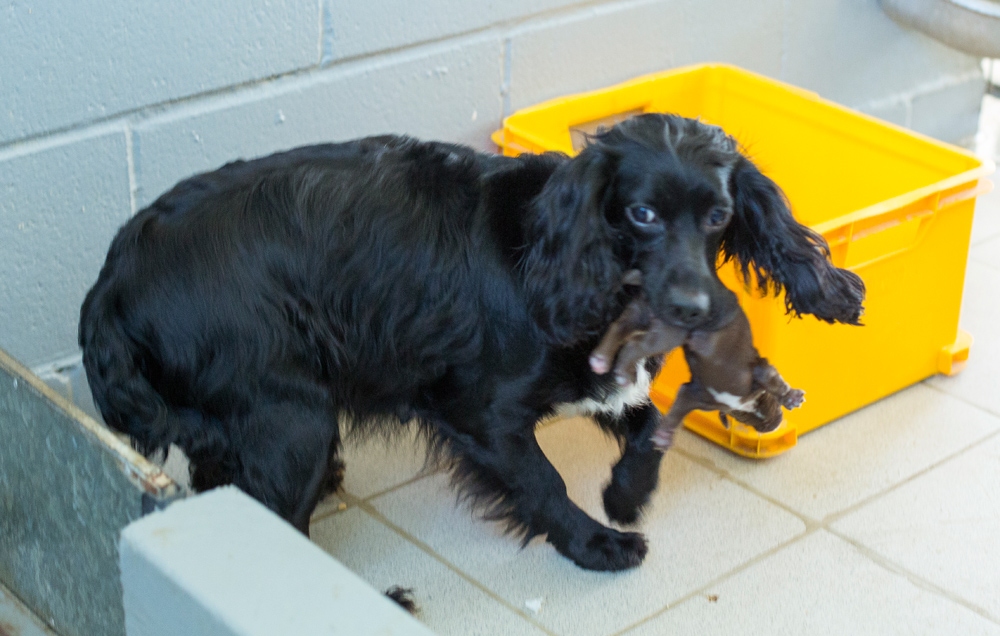
Some bitches have a strong retrieving instinct and will want to carry the puppies around. This action should be gently discouraged as it can result in accidental damage to the puppies
Vet beds are useful
Puppies are born deaf and blind and so find their way around the whelping box by smell and touch only. We put a rail in after the bitch has delivered her puppies to prevent her squashing them, and to make it easier to help her. We put a thick piece of vet bed under the rail to hold it in place. The puppies can claw their way onto the vet bed and pull themselves from underneath the bitch.
Weaning the puppies
Depending on the size of the litter and the mother’s ability to suckle the puppies, we start to supplementary feed them at four weeks old.
If puppies become noisier and restless it’s a sign that they need this additional sustenance. We give puppy food to bigger litters earlier. This is done by keeping the bitch away from the puppies for around two hours before introducing them to the food. After soaking it for about half an hour in hot tap water to make it soft like porridge, we tip it onto newspaper and let the puppies lick it up. Once they get the hang of it, we put the food into shallow bowls.
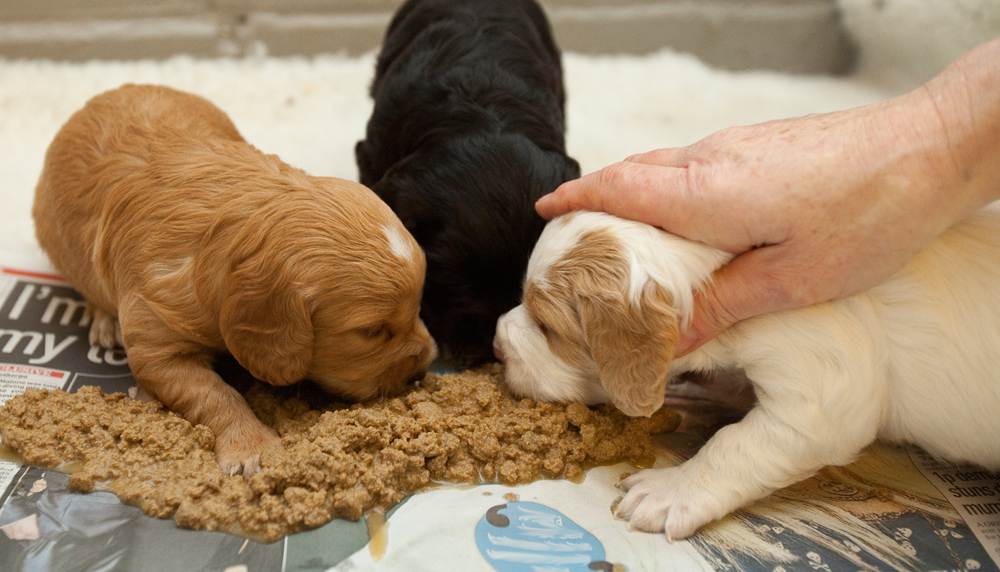
Put the soaked food onto newspaper and push the puppies’ noses into it to encourage them to start eating
We aim to have the puppies completely off the bitch by six to seven weeks of age and independently feeding on dry puppy food for at least two weeks before they leave our kennels. This makes the experience of being parted from their siblings a lot less stressful. We would never sell puppies straight off the bitch at eight weeks old.
Caring for the working bitch afterwards
Watch out for signs of milk fever. This occurs when the bitch has become low in calcium through suckling the puppies. It can occur at any time from the birth of the puppies until several weeks after weaning. The symptoms include the bitch looking unwell and not being able to stand — or falling over shortly after standing. In severe cases she will become unconscious and could die very quickly. An injection of calcium is an almost immediate cure and should be sought from your vet at soon as possible.
Another issue is mastitis. Great care should be taken to examine a bitch’s teats and udder during the weaning stage. Any signs of reddening or hardness should alert you to the early signs of mastitis. Veterinary treatment should be sought immediately as early treatment can prevent some horrendous looking holes appearing in the bitch’s udder.
After weaning their puppies, some bitches will have lost a considerable amount of condition. So once her milk has dried up, she should be wormed, flea-treated and fed on a good-quality diet with a view to building her body weight back up. You may also find at around 12 weeks after the birth of the puppies that the bitch looses a large amount of hair. We have found this not to be a long-term problem because it does grow back in time.
Related Articles
Get the latest news delivered direct to your door
Subscribe to Shooting Times & Country
Discover the ultimate companion for field sports enthusiasts with Shooting Times & Country Magazine, the UK’s leading weekly publication that has been at the forefront of shooting culture since 1882. Subscribers gain access to expert tips, comprehensive gear reviews, seasonal advice and a vibrant community of like-minded shooters.
Save on shop price when you subscribe with weekly issues featuring in-depth articles on gundog training, exclusive member offers and access to the digital back issue library. A Shooting Times & Country subscription is more than a magazine, don’t just read about the countryside; immerse yourself in its most authoritative and engaging publication.





